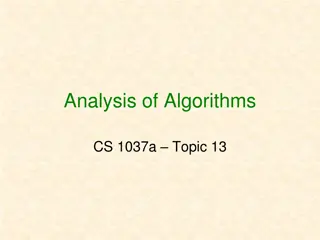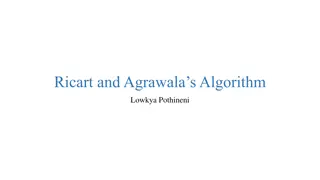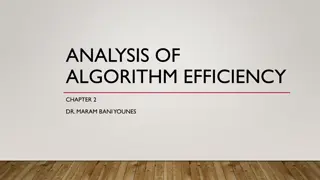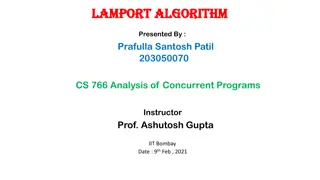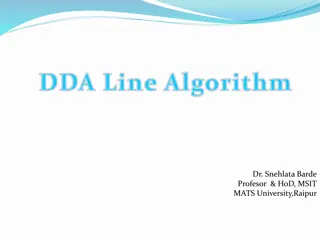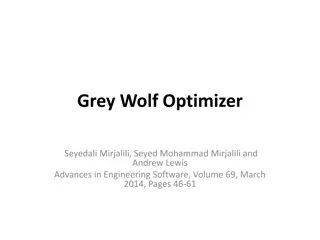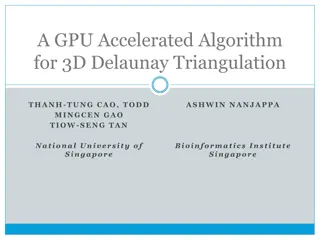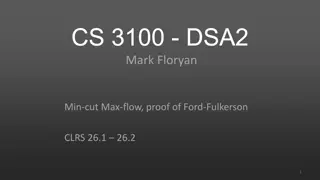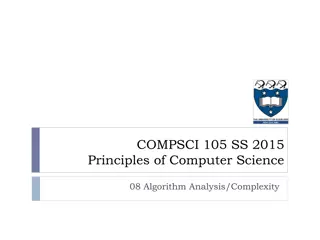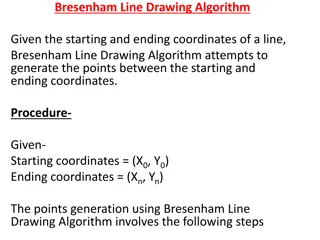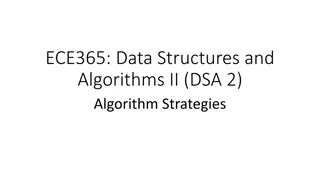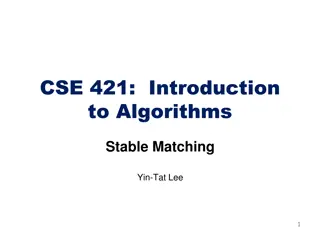Introduction to Algorithm Specification and Analysis in C
This text delves into the fundamentals of algorithm specification and analysis, emphasizing the importance of clarity, definiteness, and effectiveness in algorithm design. It covers topics such as the origins of algorithms, defining algorithm criteria, pseudocode conventions, and more. Understanding these principles is crucial for developing efficient algorithms in computer science.
Download Presentation

Please find below an Image/Link to download the presentation.
The content on the website is provided AS IS for your information and personal use only. It may not be sold, licensed, or shared on other websites without obtaining consent from the author.If you encounter any issues during the download, it is possible that the publisher has removed the file from their server.
You are allowed to download the files provided on this website for personal or commercial use, subject to the condition that they are used lawfully. All files are the property of their respective owners.
The content on the website is provided AS IS for your information and personal use only. It may not be sold, licensed, or shared on other websites without obtaining consent from the author.
E N D
Presentation Transcript
S. J. P. N. TRUSTS HIRASUGAR INSTITUTE OF TECHNOLOGY, NIDASOSHI Accredited at 'A' Grade by NAAC Programmes Accredited by NBA: CSE, ECE, EEE & ME. Department of Computer Science & Engineering Course: Design And Analysis of Algorithms (18CS42) Module 1: Introduction, What is an Algorithm? Algorithm Specification Analysis Framework Prof. C. R. Belavi Asst. Prof. , Dept. of Computer Science & Engg., Hirasugar Institute of Technology, Nidasoshi Prof. C. R. Belavi, Department of CSE, HSIT, Nidaoshi 3/4/2025 1
Introduction The word ALGORITHM comes from the name of a Persian author, Abu Ja far Mohammed ibn Musa al Khowarizmi (c. 825A.D.), who wrote mathematics This word has taken on a special significance in computer science, where ALGORITHM has come to refer to a method that can be used by a computer for the solution of a problem a textbook on Prof. C. R. Belavi, Department of CSE, HSIT, Nidaoshi 3/4/2025 2
What is an Algorithm An ALGORITHM is a finite set of instructions that, if followed, accomplishes a particular task. In addition, all algorithm must satisfy the following criteria: 1. Input Zero or more quantities are externally supplied 2. Output At least one quantity is produced 3. Definiteness Each instruction is clear and unambiguous 4. Finiteness After tracing all instructions in ALG, the ALG terminates after a finite number of steps 5. Effectiveness - Every instruction must be very basic so that it can be carried out, in principle, by a person using only pencil and paper. Also each operation must feasible Prof. C. R. Belavi, Department of CSE, HSIT, Nidaoshi 3/4/2025 3
Algorithm Specification Pseudocode Conventions ALG can be described using many ways Graphic representation called flowcharts are another possibility, but they work well only if the algorithm is small and simple In this text we present most of our algorithm using a Pseudocode that resembles C program 1. Comments begins with // and continue until the end of line 2. Blocks are indicated with matching braces { and } 3. An identifier begins with a letter. The data types of variables are not explicitly declared Prof. C. R. Belavi, Department of CSE, HSIT, Nidaoshi 3/4/2025 4
Algorithm Specification Pseudocode Conventions Assignment of values to variables is done using the assignment statement - <variable> = <expression>; Boolean values true and false, logical operators and, or and not, relational operators - <, >, == etc. are provided Elements of multidimensional arrays are accessed using [ and ]. Array indices start at zero for, while and repeat-until looping statements are provided- While < condition> do for variable:= value1 to value2 step step do { { statement1; statement1; . . statementn; statementn; } } 4. 5. 6. 7. 3/4/2025 Prof. C. R. Belavi, Department of CSE, HSIT, Nidaoshi 5
Pseudocode Conventions A repeat-until statement is constructed as follows- repeat <statement1> . <statementn> until<condition> 8. A conditional statements has the following forms- if <condition> then <statement> if <condition> then <statement1> else <statement2> case { :<condition1>: <statement1>; :<condition1>: <statement1>; :else: <statement n + 1> } Prof. C. R. Belavi, Department of CSE, HSIT, Nidaoshi 3/4/2025 6
Pseudocode Conventions 9. Input and Output are done using the instruction read and write 10. An algorithm consists of a heading and a body Algorithm Name (<parameter list>) Example:- ALG to find maximum element in Array Prof. C. R. Belavi, Department of CSE, HSIT, Nidaoshi 3/4/2025 7
Recursive Algorithms A recursive function is a function that is defined in terms of itself An ALG that calls itself is direct recursive ALG A is said to be indirect recursive if it calls another algorithm which in turns calls A Prof. C. R. Belavi, Department of CSE, HSIT, Nidaoshi 3/4/2025 8
Analysis Framework There are two kinds of efficiency Time and Space Time efficiency indicates how fast an algorithm in question runs Space efficiency deals with the extra space the algorithm requires Measuring an Input s size almost all ALGs run longer on larger inputs. For example, it takes longer to sort larger arrays, multiply larger matrices, and so on Units for Measuring Running Time measuring an ALGs running time, simply can use a standard unit as seconds, milliseconds and so on. But, practically to identify the most important operation of the algorithm, called the basic operation, the operation contributing the most to the total running time, and compute the number of times the basic operation is executed. Hence, we can estimate, T(n) CopC(n), where T(n) is running time of a program, Cop be the execution time of an ALGs basic operation on a particular computer, and C(n) be the number of times this basic operation needs to be executed for this algorithm. Prof. C. R. Belavi, Department of CSE, HSIT, Nidaoshi 3/4/2025 9
Analysis Framework Worst-Case Efficiency of an ALG is its efficiency for the worst-case input of size n, which is an input of size for which the algorithm runs the longest among all possible inputs of that size. Example Cworst(n)=n Best-Case Efficiency - of an ALG is its efficiency for the best-case input of size n, which is an input of size for which the algorithm runs the fastest among all possible inputs of that size. Example Cbest(n)=1 Average-Case Efficiency - Example Cavg(n)=p(n+1)/2 + n(1-p) Prof. C. R. Belavi, Department of CSE, HSIT, Nidaoshi 3/4/2025 10
Performance Analysis Major goal of this subject is to develop skills for making evaluative judgments about algorithm There are many criteria upon which we judge algorithm- 1. Does it do what we want it to do? 2. Does it work correctly according to the original specification of the task? 3. Is there documentation that describes how to use it and how it works? 4. Are procedures created in such a way that they perform logical sub- functions? 5. Is the code readable? There are other important criteria for judging algorithms that have a more direct relationship to performance 1. Space Complexity ( Storage Requirement ) 2. Time Complexity ( Computing Time ) Prof. C. R. Belavi, Department of CSE, HSIT, Nidaoshi 3/4/2025 11
Space Complexity ( Storage Requirement ) The space complexity of an algorithm is the amount of memory it needs to run to completion The space needed is the sum of a fixed part and variable part 1. Fixed Part is independent of characters of the inputs and outputs. It includes instruction space(space for code), space for simple variables and fixed size component variables, space for constants etc. 2. Variable Part consists of the space needed by component variables whose size is dependent on the particular problem instance being solved, the space needed by referenced variables and recursion stack space The space requirement S(P) of any algorithm P may therefore be written as S(P) = c + Sp(instance characteristics) , where c is constant Prof. C. R. Belavi, Department of CSE, HSIT, Nidaoshi 3/4/2025 12
Time Complexity ( Computing Time) The time complexity of an algorithm is the amount of computer time it needs to run to completion The time T(P) taken by a program P is the sum of the compile time and the run ( or execution time) The compile time does not depend on the instance characteristics Hence, we concern with just the run time of a program This run time is denoted characteristics) by tp(instance Prof. C. R. Belavi, Department of CSE, HSIT, Nidaoshi 3/4/2025 13
Step Count for Array Element Addition Prof. C. R. Belavi, Department of CSE, HSIT, Nidaoshi 3/4/2025 14
Step Count for Two Matrix Addition Prof. C. R. Belavi, Department of CSE, HSIT, Nidaoshi 3/4/2025 15
Step Count for Rsum of Array Elements Prof. C. R. Belavi, Department of CSE, HSIT, Nidaoshi 3/4/2025 16
Module 1 Asymptotic Notations Big-Oh notation (O) Big-Omega notation ( ) Big-Theta notation (Q) Mr. C. R. BELAVI Dept. of CSE, HIT, Nidasoshi Prof. C. R. Belavi, Department of CSE, HSIT, Nidaoshi 3/4/2025 17
Asymptotic Notations The concentrates on the order of growth of an algorithm s basic operation count as the principal indicator of the algorithm s efficiency To compare and rank such orders of growth, computer scientists use three notations:- Big-Oh notation (O), Big-Omega notation ( ) and Big-Theta notation ( ) efficiency analysis framework Prof. C. R. Belavi, Department of CSE, HSIT, Nidaoshi 3/4/2025 18
Big-Oh notation (O) A function t(n) is said to be in O(g(n)), denoted t(n) O(g(n)), if t(n) is bounded some constant multiple of g(n) for all large n, i.e., if there exist some positive constant c and some integer n0 such that t(n) cg(n) for all n n0 above by nonnegative Prof. C. R. Belavi, Department of CSE, HSIT, Nidaoshi 3/4/2025 19
Big-Oh notation (O) - Example Prove the following example 100n + 5 O(n2) Solution:- 100n + 5 100n + n = n(100+1) = 101n Hence Constant, c = 101 Hence, 100n + 5 O(n2) for all n 5 and constant c=101 Prove the following example 10n2+ 4n + 2 O(n2) Solution - = 10n2 +n2 = n2( 10 + 1) = 11n2 Hence, constant, c = 11 Hence, 10n2+ 4n + 2 O(n2) for all n 5 and constant c=11 Prof. C. R. Belavi, Department of CSE, HSIT, Nidaoshi 3/4/2025 20
Big-Omega notation () A function t(n) is said to be in (g(n)), denoted t(n) (g(n)), if t(n) is bounded below by some positive constant multiple of g(n) for all large n, i.e., if there positive constant c and some integers n0 such that t(n) cg(n) for all n n0 exist some nonnegative Prof. C. R. Belavi, Department of CSE, HSIT, Nidaoshi 3/4/2025 21
Big-Omega notation () - Example Prove the following examples- 1. n3 (n2) - where n3 becomes than n2 when we select constant, c=1 and n0=0 2. 3n + 2 (n) - where 3n + 2 becomes greater than nwhen we select constant, c=3 and n0=0 Prove the following examples- 3. 3n + 3 (1) - where 3n + 3 becomes greater than 1 when we select constant, c=3 and n0=0 4. 6 * 2n + n2 (2n) - where 6 * 2n + n2 becomes greater than 2n when we select constant, c=6 and n0=0 greater Prof. C. R. Belavi, Department of CSE, HSIT, Nidaoshi 3/4/2025 22
Big-Theta notation () A function t(n) is said to be in (g(n)), denoted t(n) (g(n)), if t(n) is bounded both above and below by some positive constant multiples of g(n) for all large n, i.e., if there exist some positive constant c1 and c2 and some nonnegative integers n0 such that c2g(n) t(n) c1g(n) for all n n0 Prof. C. R. Belavi, Department of CSE, HSIT, Nidaoshi 3/4/2025 23
Big-Theta notation () - Example Prove the following example of Big-Theta 3n + 2 (n) Solution:- For 3n + 2 n, constant c1 = 3 For 3n + 2 n, = 3n + n = n (3 + 1) = 4n, constant c2 = 4 Hence 3n+2 (n) with constant c1=3, c2=4 and for all n 2 Prof. C. R. Belavi, Department of CSE, HSIT, Nidaoshi 3/4/2025 24
Basic Asymptotic Efficiency Classes Prof. C. R. Belavi, Department of CSE, HSIT, Nidaoshi 3/4/2025 25
Module - 1 Mathematical analysis of Non-Recursive Algorithms with Examples Mathematical analysis Algorithms with Examples (T1:2.2, 2.3, 2.4). Mr. C. R. BELAVI Dept. of CSE, HIT, Nidasoshi Prof. C. R. Belavi, Department of CSE, HSIT, Nidaoshi of Recursive 3/4/2025 26
Mathematical analysis of Non-Recursive Algorithms with Examples General plan for Analyzing Time Efficiency of Non-Recursive algorithms- 1. Decide on a parameter/parameter s indicating an input size 2. Identify the algorithm s basic operation 3. Check whether the number of times the basic operation is executed depends only on the size of an input. If it also depends on some additional property, the worst-case, average-case and best-case efficiencies have to be investigated seperately 4. Set up a sum expressing the number of times the algorithm s basic operation is executed 5. Using standard formulas and rules of sum manipulation, either find a closed-form formula for the count or, at the very least, establish its order of growth Prof. C. R. Belavi, Department of CSE, HSIT, Nidaoshi 3/4/2025 27
Summation Rules & Formulas Summation Rules Summation Formulae Prof. C. R. Belavi, Department of CSE, HSIT, Nidaoshi 3/4/2025 28
Element Uniqueness Problem Prof. C. R. Belavi, Department of CSE, HSIT, Nidaoshi 3/4/2025 29
Matrix Multiplication Example Prof. C. R. Belavi, Department of CSE, HSIT, Nidaoshi 3/4/2025 30
Mathematical analysis of Recursive Algorithms with Examples General plan for Analyzing Time Efficiency of Non-Recursive algorithms- 1. Decide on a parameter/parameter s indicating an input s size 2. Identify the algorithm s basic operation 3. Check whether the number of times the basic operation is executed can vary on different inputs of the same size; if it can, the worst- case, average-case and best-case efficiencies must be investigated separately 4. Set up a recurrence relation, with an appropriate initial condition for number of times the basic operation is executed. 5. Solve the recurrence or at least ascertain the order of growth of its solution Prof. C. R. Belavi, Department of CSE, HSIT, Nidaoshi 3/4/2025 31
Tower of Hanoi Example Prof. C. R. Belavi, Department of CSE, HSIT, Nidaoshi 3/4/2025 32
Tower of Hanoi Example Prof. C. R. Belavi, Department of CSE, HSIT, Nidaoshi 3/4/2025 33
Module - 1 Important Problem Types 1. 2. 3. 4. 5. Sorting Searching String processing Graph Problems Combinatorial Problems Mr. C. R. BELAVI Dept. of CSE, HIT, Nidasoshi Prof. C. R. Belavi, Department of CSE, HSIT, Nidaoshi 3/4/2025 34
Important Problem Types Sorting- The sorting problem asks us to rearrange the items of a given list in ascending or descending order. As a practical matter, we need to sort list of numbers, characters from alphabets, character string and most important records about students, employees, libraries about holding books etc.. The special piece of information called key is used to sort list items. For example, student name, number or grade point in student records. Many types of sorting algorithms are quick sort, merge sort, bubble sort, selection sort etc. Searching- The searching problem deals with finding a given value, called a search key, in a given set. There are two types of searching algorithms sequential searching and binary searching Prof. C. R. Belavi, Department of CSE, HSIT, Nidaoshi 3/4/2025 35
Important Problem Types String Processing- a string is a sequence of characters from an alphabets. Text strings comprise letters, numbers and special characters. Bit strings comprise of zeros and once. String processing ALGs are important for computer languages and compiling issues. Several string processing algorithms are available like string matching, string comparison, string concatenation, finding string length etc. Graph Problems- A graph can be thought of as a collection of points called vertices, some of which are connected by line segments called edges. Graphs can be used for modeling a wide variety of real-life applications, including transportation and communication network, project scheduling and games. Examples are Traveling Salesman Problem, Graph Coloring etc. Prof. C. R. Belavi, Department of CSE, HSIT, Nidaoshi 3/4/2025 36
Important Problem Types Combinatorial Problems- The Travelling Salesman Problem and Graph Coloring Problem are examples of combinatorial problems. These are problems that ask (explicitly or implicitly) to find a combinatorial object such as a permutation, a combination, or a subset that satisfies certain constraints and has some desired property ( e.g., maximize a value or minimize a cost) Geometric Problems- Geometric algorithms deals with geometric objects such as points, lines and polygons. Ancient Greeks developed solution for variety of geometric problems, including problems of constructing simple geometric shapes- triangles, circles and so on Numerical Problems- Numerical problems, are problems that involve mathematical objects of continuous nature: solving equations and systems of equations, computing definite integrals, evaluating functions and so on Prof. C. R. Belavi, Department of CSE, HSIT, Nidaoshi 3/4/2025 37
Module - 1 Fundamental Data Structures 1. Stacks 2. Queues 3. Graphs 4. Trees 5. Sets and Dictionaries Mr. C. R. BELAVI Dept. of CSE, HIT, Nidasoshi Prof. C. R. Belavi, Department of CSE, HSIT, Nidaoshi 3/4/2025 38
Fundamental Data Structures A data structure can be defined as a particular scheme of organizing related data items Linear data structures are array and linked lists Array - A (one dimensional) array is a sequence of n items of the same data type that are stored contiguously in computer memory and made accessible by specifying a value of the array s index as shown in below figure- Item[0] Item[1] Item[n-1] Prof. C. R. Belavi, Department of CSE, HSIT, Nidaoshi 3/4/2025 39
Fundamental Data Structures A linked list is a sequence of zero or more elements called nodes each containing two kinds of information: some data and one or more links called pointers to other nodes of the linked list. Two types of linked lists are singly linked lists and doubly linked lists. There working principles are shown in below diagram- Prof. C. R. Belavi, Department of CSE, HSIT, Nidaoshi 3/4/2025 40
Fundamental Data Structures Stack- A Stack is a list in which insertions and deletions can be done only at the end. This end is called the top because a stack is usually visualized not horizontally but vertically. It operates in the last-in-first-out (LIFO) fashion. Queue- is a list from which elements are deleted from one end of the structure, called the front (dequeue), and new elements are added to the other end, called the rear (enqueue). It operates in the firstt-in-first-out (FIFO) fashion. Prof. C. R. Belavi, Department of CSE, HSIT, Nidaoshi 3/4/2025 41
Fundamental Data Structures Graphs- A graph G=<V,E> is defined by a pair of two sets: a finite set V of items called vertices and a set E of pairs of these items called edges Prof. C. R. Belavi, Department of CSE, HSIT, Nidaoshi 3/4/2025 42
Fundamental Data Structures Graph Representation- A graphs for computer algorithms can be represented in two principal ways the adjacency matrix and adjacency lists Prof. C. R. Belavi, Department of CSE, HSIT, Nidaoshi 3/4/2025 43
Fundamental Data Structures Weighted Graph - A weighted graph is a graph with numbers assigned to its edges. These numbers are called weights or costs. Prof. C. R. Belavi, Department of CSE, HSIT, Nidaoshi 3/4/2025 44
Fundamental Data Structures Trees A tree is a connected acyclic graph. A graph that has no cycles but is not necessarily connected is called a forest. Prof. C. R. Belavi, Department of CSE, HSIT, Nidaoshi 3/4/2025 45
Fundamental Data Structures Free Tree & Rooted Trees Prof. C. R. Belavi, Department of CSE, HSIT, Nidaoshi 3/4/2025 46
Fundamental Data Structures Sets and Dictionaries- The notion of a set plays a central role in mathematics. A set - can be described as an unordered collection of distinct items called elements of the set The dictionary - a data structure that implements three operations that is searching for a given item, adding a new item and deleting an item on given set or multiset is called dictionary Prof. C. R. Belavi, Department of CSE, HSIT, Nidaoshi 3/4/2025 47




